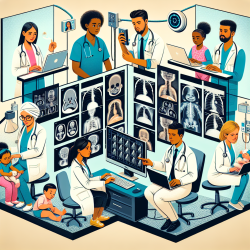Introduction
The landscape of healthcare delivery is rapidly evolving, with telehealth services playing a pivotal role in enhancing access to medical care. Teleradiology, a subset of telehealth, has emerged as a significant innovation, particularly in pediatric orthopedics. A recent study titled "Evaluating Pediatric Orthopedic Teleradiology Services at a Tertiary Care Centre" provides valuable insights into the effectiveness of teleradiology in improving healthcare delivery. This blog explores how practitioners can leverage these findings to enhance their skills and patient outcomes.
Key Findings from the Study
The study conducted a retrospective review of 80 pediatric patients who received teleradiology consultations between 2015 and 2018. The findings revealed substantial travel distance savings for families, averaging 1167 km per patient. This reduction in travel not only alleviated logistical burdens but also ensured continuity of care without compromising the quality of medical services.
Key demographics from the study included:
- Mean age of patients: 3.5 years
- Gender distribution: 66 females and 14 males
- Common diagnoses: Developmental Dysplasia of the Hip (DDH), cerebral palsy, and osteogenesis imperfecta
Implications for Practitioners
The implementation of teleradiology services offers several advantages for healthcare practitioners:
- Enhanced Access: Patients can receive specialized consultations without the need for extensive travel, making healthcare more accessible, especially for those in remote areas.
- Continuity of Care: Teleradiology ensures consistent monitoring and follow-up, crucial for conditions like DDH where regular imaging is required.
- Resource Optimization: By reducing in-person visits, healthcare facilities can allocate resources more efficiently, potentially reducing wait times for other patients.
Encouraging Further Research
While the study provides a solid foundation, further research is essential to explore the broader applications of teleradiology. Practitioners are encouraged to consider the following areas for future investigation:
- Patient Experience: Conducting surveys to assess patient and family satisfaction with teleradiology services.
- Cost-Benefit Analysis: Evaluating the economic impact of teleradiology on healthcare systems and families.
- Technological Integration: Investigating the integration of advanced technologies, such as AI, to enhance diagnostic accuracy and efficiency.
Conclusion
Teleradiology represents a transformative approach in pediatric orthopedics, offering significant benefits in terms of accessibility, continuity of care, and resource optimization. By embracing these services, practitioners can improve patient outcomes and contribute to a more efficient healthcare system. To delve deeper into the study, practitioners are encouraged to read the original research paper: Evaluating Pediatric Orthopedic Teleradiology Services at a Tertiary Care Centre.










